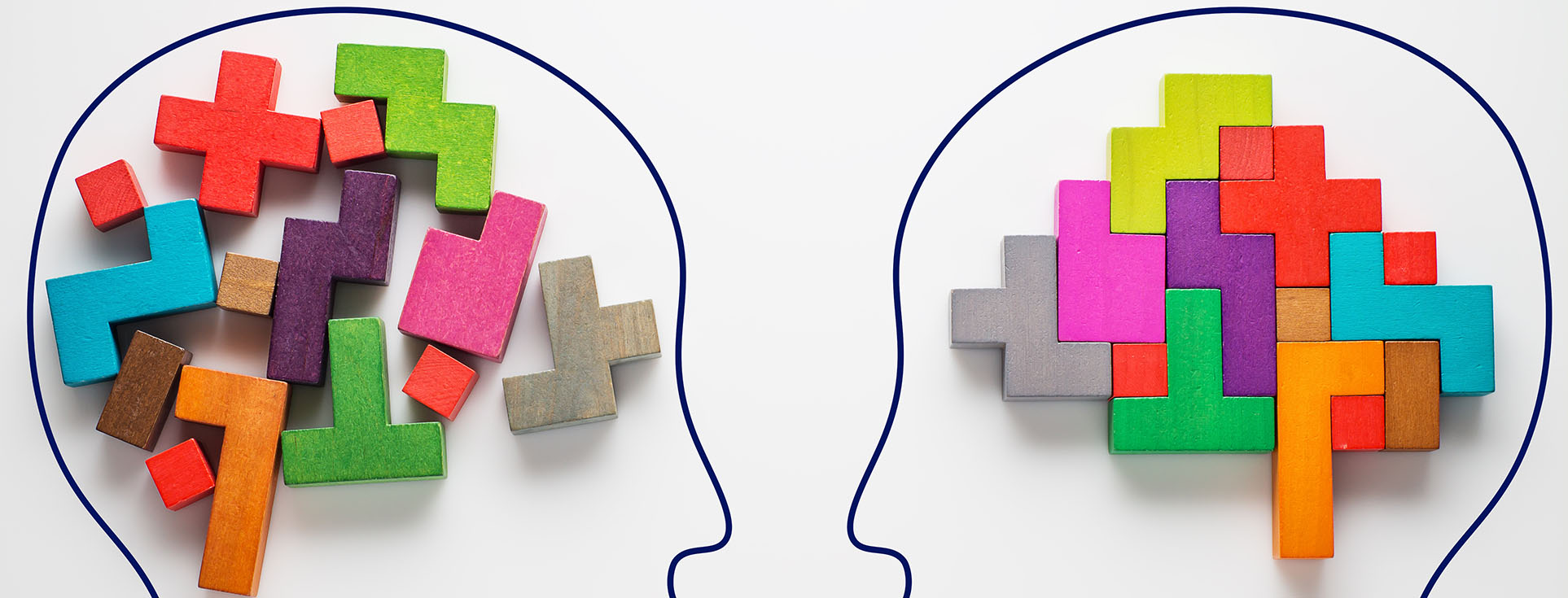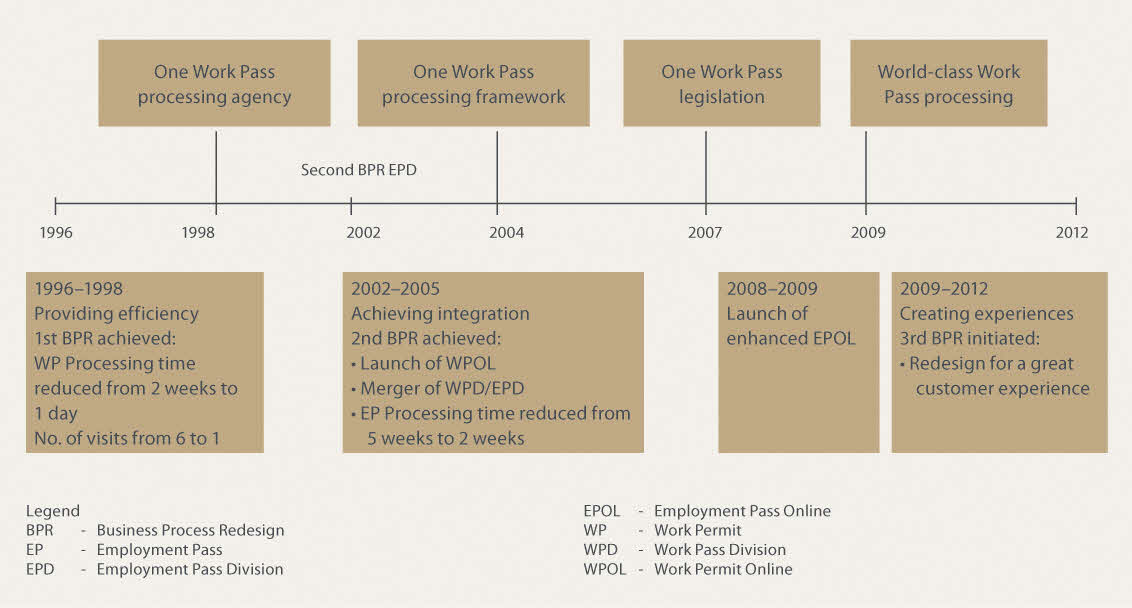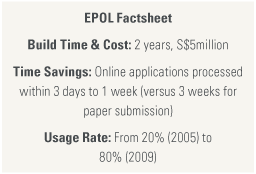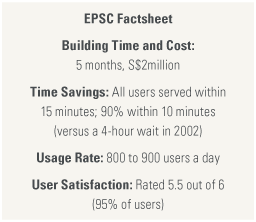Redesigning the Service Experience
ETHOS Issue 08, Aug 2010

Forward-looking public organisations seeking to enhance public value and reduce the inconvenience of public services have often pursued reforms on the basis of efficiency gains. However, there are limits to how much more efficient processes can be made, and the marginal utility of faster services declines sharply after a point; speedy service soon becomes a given. Instead, process-oriented agencies stand to gain when they look beyond incremental efficiency improvements and consider ways in which their services can allow for more meaningful engagement with their users.
When relevant intangibles are taken into account, and the planning approach allows for the gradual discovery of users' true needs (which may not be the ones which users fully articulate), service transformation can occur. This can lead to a fundamental rethinking of services in terms of their concept (e.g. reliability, accessibility, availability), delivery (e.g. service centre, web portal) or communication (e.g. information management, unique propositions).
In 2009, the Ministry of Manpower's Work Pass Division (WPD) used design thinking as a tool to develop better ways to support foreigners who choose Singapore as a destination to live, work and set up businesses. The process of applying for an Employment Pass used to be a laborious 13-step procedure with long waiting times for both employers and foreigners.
Redesigning Employment Pass Services
In 2009, the Ministry of Manpower's Work Pass Division (WPD) used design thinking as a tool to develop better ways to support foreigners who choose Singapore as a destination to live, work and set up businesses. The process of applying for an Employment Pass used to be a laborious 13-step procedure with long waiting times for both employers and foreigners.
Process re-engineering efforts in 1996 and 2002 were geared towards reducing processing times, since it was believed customers most desired speed in their applications. It was also easier to derive indicators for efficiency.
In 2009, design thinking methods were applied for the first time. Instead of looking at Employment Pass services as a series of functional processes, WPD began to consider them through the eyes of their users — the employers, employment agencies and foreign workers. The Work Pass application transaction was recast as an experience — applicants were not units to be moved from point to point in the process but instead were individuals with aspirations, preferences and relationships. The new orientation made clear that Singapore's demand for their contributions was as important as their desire to have a pleasant experience living and working in the city.
The service redesign process required a better understanding of the decision points of both users and non-users. This involved taking a closer look at the opportunities and difficulties facing users, including those who had succeeded and failed within it, or had encountered problems or avoided it.
Figure 1. A CHRONOLOGY OF THE WORK PASS DIVISION'S BUSINESS PROCESS RE-ENGINEERING

Source: Ministry of Manpower Work Pass Division
Two Key Service Touchpoints
The Employment Pass service involves two critical touchpoints: the Employment Pass OnLine (EPOL) system which applicants first encounter while still in their home countries, and the Employment Pass Services Centre (EPSC) where applicants visit Singapore to submit documents for verification, register biometric data and complete their application.
EPOL

The EPOL was first offered in 2002 but it had limited functions. Fewer than 20% of applications were submitted through the system, leaving some 25,000 hardcopy applications to be received and manually processed each month. Applicants had little information on how applications were evaluated.
Between 2005 and 2009, the EPOL was enhanced and redesigned to increase the information flow to users of the system. This has helped to shift the perception of WPD from an opaque and high-handed regulator to that of a responsive and transparent facilitator of employment. An Employment Pass Self Assessment Tool was introduced to help employers and applicants determine the likelihood that their applications would be approved, minimising efforts wasted on clearly non-qualifying applications. In this collaborative spirit, employers of EP applicants take ownership of the process by ensuring that their background checks on candidate employees meet the stipulated guidelines.
The new EPOL serves two critical functions: it is an information portal for applicants, accessible to anyone anywhere in the world who may be considering taking up employment in Singapore. It is also a direct channel of communication between applicants and the WPD; applicants can submit or cancel applications, check their eligibility and application status, or seek clarifications through email from WPD officers.
EPSC

Using design thinking methodology, the EPSC was reconceived as a space where user experience would determine how its various service transactions flowed. Space design insights and ideas were derived from field observation of the way users navigated existing systems. Trial solutions were then visualised and translated into quick, rough, life-sized prototypes of the new Centre, and tested for feasibility. WPD staff, employers and current users were invited to try out the prototypes, and their feedback helped to further refine EPSC design, production and operation.
Field observation was preferred over surveys and focus groups because it could give clues to instinctive, non-verbal behaviours, which users might not have been able to articulate in a formal manner. Special attention was paid to outlier and extreme users of services, because these exceptions could lead to radical new insights or solutions. One of these insights was that users appreciate certainty in their application — such as waiting times, outcomes, or even whether their applications have been received. As a result, visits to the EPSC are now appointment-based, ensuring that applicants would be served at their selected date and time.
The form and function of the Centre were redrawn to create the desired user-centred experience. The space was divided into three areas according to their distinctive roles: the arrival lobby, the waiting area, and the enrolment bar.
The new arrival lobby has been kept uncluttered as a space for guests to step away from the hustle and bustle of the streets when entering the Centre. Customer service staff, known as service ambassadors, greet visitors at the arrival lobby at once and guide them in using the Centre. These ambassadors replace unwieldy counter queues, complicated signage and awkward navigation, reducing the chances of disorientation during a user's first visit.
Within the waiting area, a main service counter occupies the center of the room (which by convention would have been taken up by rows of hard-backed chairs and numeric queue prompters). This brings the service experience to the fore and closer to users. Wall-to-wall counters have been replaced by purpose-built modular service counters; no longer do counters appear frustratingly unmanned if service staff step away from their posts. Waiting areas recede against the perimeter of the room, with clear window views overlooking the Singapore River and the city skyline, offering a pleasant waiting environment. Adding to the sense of personalised service, a single-row display for names has replaced the old, large numeric queue number displays.
The new enrolment bars are sites for recording applicants' biometric data, photo-images and verifying submitted documents. The name is a deliberate move away from the clinical notion of a fingerprinting "service desk" and reinforces its envisioned role, which is to assist in the enrolment of a foreigner into the workforce. Different service points cater to users with special needs, such as those with families in tow or physical difficulties. Some of these points are family cabanas and play corners to occupy young children as they wait with their parents to be served. The interior design and layout are inspired by those of banks, restaurants, airport lounges and shopping malls; there are café-styled booths to create a relaxed atmosphere while documentation and other procedures are taking place.
A "DESIGNFUL" 1 ORGANISATION
Design thinking is a methodology to develop products and services, solve problems or create experiences. It is an approach that applies human-centred and creative principles to create a desired future. Design thinking requires strategy and implementation to happen at the same time where, at every stage, ideation (strategy development) is interlinked to "making" (implementation and production). New insights are formed while moving from idea to operation, and vice versa. It is this integrated and iterative interplay between strategy and implementation which brings about innovation.
While design thinking has gained currency in the private sector, it has yet to become widespread in the public sector. There are several reasons why this might be so. First, such an approach may appear irrational, abstract or even extravagant with outcomes that may not be directly measurable or tangible and hence at odds with the quantitative indicators that customarily account for public spending. Second, design is often regarded, at best, as a good-to-have element in support of other key public roles instead of being itself a strategic function of operational planning. Third, most public agencies are the sole providers of unique and often mandated services; there is inherently no strong impetus to radically reinvent their services and operations, and little comparative basis with which to make changes.
Three factors can determine a public organisation's success in using design thinking to transform service provision: a design thinking mindset, appropriate methodologies, and the infusion of design thinking into the organisation's culture and core competency.
Mindset
Service transformation through design thinking happens when there is an appreciation of the value of design principles to continually discover insights about the customer. At the same time, the organisation must have the capacity to experiment, take risks and explore radical possibilities. It is also important to have someone within the organisation who can champion and demonstrate the benefits of design thinking for service innovation. Throughout the service redesign process, users are active participants at the heart of service transformation. This change in mindset can drive behaviours which in turn allow for more refinement and reinvention of service to take place.
Methodology
The choice of an appropriate design thinking methodology depends on the agency's experience with the concept. Agencies that are new to the approach would benefit from the appointment of qualified design consultants who are able to transfer knowledge of the methodology to their clients.2 Such client-consultant partnerships allow public agencies who are new to the design thinking methodology to learn how the consultant uses the process, and gain hands-on experience in the approach by directly participating in the development of service prototypes.
The challenge many public organisations will face is how to reconcile the use of abstract and intangible elements in the creation of the absolute and the concrete.
Organisational Culture and Competency
Structurally, design thinking must be part of the organisation's long-term and short-term planning, as well as day-to-day decision-making throughout the entire value chain: from product and service development to planning, communications, and service delivery. In the early years of design thinking development, the emphasis is often placed on maximising participation and buy-in to the process among staff, service partners and users, as services are prototyped and redesigned.
Once employees are empowered and confident enough to ask difficult questions, they will learn to push the envelope of existing parameters, and begin to exhibit design thinking across their work. The real test of success is how the agency sustains design thinking as part of its corporate culture, where both management and the line staff apply design thinking principles in the way all strategies and projects are conceptualised and implemented in the organisation.
CONCLUSION
Design thinking does not encourage thinking out of the box; it is about recognising that there is no box. It draws attention to the need to imagine a new space and establish fresh parameters in order to generate the right experience and potentially transform the perception and meaning of public service. The challenge many public organisations will face is how to reconcile the use of abstract and intangible elements in the creation of the absolute and the concrete; how to bridge the gap between utility and experience, in order to anticipate new needs, environments and futures.
NOTES
- Neumeier, Marty, The Designful Company: How to Build a Culture of Nonstop Innovation (USA: New Riders, 2009).
- MOM worked closely with design consultancy, IDEO LLC, for the Work Pass Division's third Business Process Re-engineering and the EPSC was the first project deliverable as a result of this collaboration.

